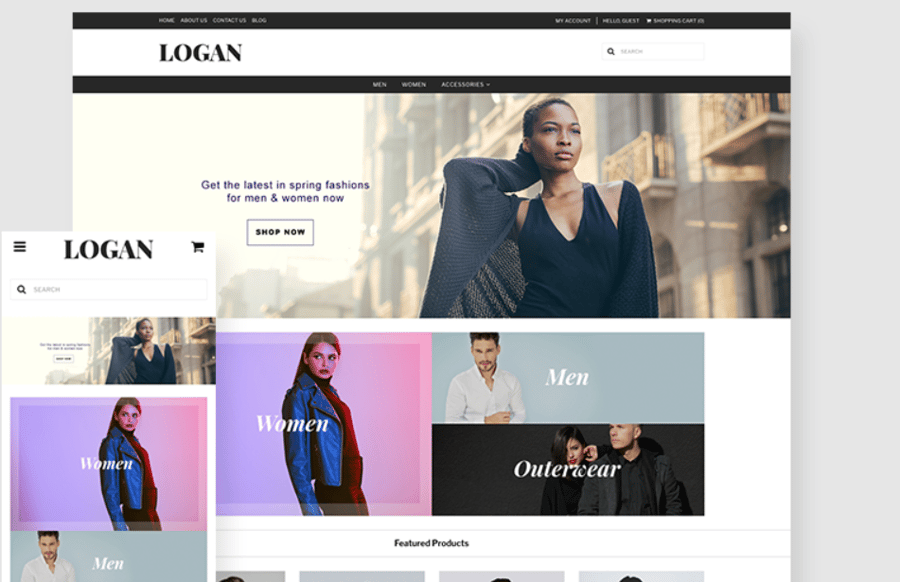
Aside from the toilet paper shortages and newly-formed streaming service addictions, the pandemic has also given rise to a number of more positive trends, like a huge boom in new startups that have given people from all walks of life the excuse they need to pursue their entrepreneurial dreams.
If you’re one of the people who made the plunge and started a clothing business over the past few years, and you’re now looking to take your passion project to the next level, then you may be trying to figure out the best way to move your brick-and-mortar business online.
In this guide, we’ll walk you through a 7-step strategy towards taking your business online, with actionable steps to help you form a roadmap for your own unique vision.
Step 1: Buy a Domain Name
The first step to taking any business online is to find a good domain name. You’ll be pleased to know that we’re starting easy here, and domain registrars like GoDaddy can be used to purchase a .com domain name for as little as $22, with ownership lasting for two years. Alternatively, your eCommerce platform of choice may be able to register a free domain name for your online store.
Though this is a relatively quick and easy process, it’s important to note this one detail can have a major impact on all future online branding. When you sit down to pick your domain name, there are a few things to bear in mind:
- Use your brand name or a close variation.
- Always purchase a .com domain name where possible, as this is the most common and trustworthy domain extension.
- Avoid numbers and hyphens to maintain a professional, memorable, and recognizable domain name.
- Even if a domain name is available on a domain registrar’s website, there’s a chance that it could contain trademarked terms. Be sure to research your domain name thoroughly before purchasing it, as a slip-up could land you in legal trouble later on.
Step 2: Build your Site
Now that you have a domain name in place, the next step is to build a good website.
As you’re looking to sell products online, you’ll want to build your site through an eCommerce platform that’s specifically designed for this purpose. There’s a wide range of eCommerce platforms on the market, so you’ll want to choose one that fits your business’s specific needs. For example, Shift4Shop is an affordable and accessible option that comes with a long list of built-in features, which would be a fitting solution for a startup that needs a complete website without coding.
If your business is fairly small, then the structure of your site may seem like a pretty cut-and-dry issue. However, as your business grows, you’ll find it progressively more challenging to structure your site in a logical, user-friendly way.
To set your store up for success now and in the future, consider a few fundamental eCommerce design conventions.
- Minimize the steps from your homepage to the checkout for a clear conversion path that avoids confusion and abandoned carts.
- Showcase customer testimonials and encourage public product reviews.
- Make your customer service easily accessible so you can quash technical issues quickly.
- Use a responsive platform to ensure your website is aesthetically pleasing on all computers and mobile devices.
By putting your customer at the heart of all your site-building decisions and taking cues from the online clothing stores you love, you can ensure positive experiences and satisfied customers from your first day of selling online.
Step 3: Design Your Site

Now we get to the fun part — designing the aesthetics of your site.
Most major eCommerce platforms will offer you a range of themes when you first set up your account. Your choice here won’t matter much in the long run, but we recommend choosing one that’s both simple and professional-looking, as this will make it easier to develop a user-friendly shopping experience.
From there, you can have fun customizing your store to reflect your brand identity. By playing with the font, background, and navigation design, using images and video content to showcase your best products, and arranging your products in unique and interesting ways, you’ll soon be able to create a store that delights your customers and reflects your unique brand.
Though this design phase is your chance to get creative, it’s important to keep a certain level of consistency throughout your pages to ensure a positive user experience. It’s good to make your site distinctive and memorable, but remember that your site is, first and foremost, a functional entity, which should be easy to use and navigate for any visitors.
Step 4: Work on SEO
Google is a big place, and even though you might have great products and compelling copy, people won’t be able to find your website unless it’s optimized to rank for popular search terms.
SEO is a complex topic that’s too broad to cover in detail here. Having said that, there are a few core elements to focus on when you first move your clothing business online.
Keyword Optimization
Your first step should be researching the kinds of terms people are using to find businesses like yours, then incorporating these terms logically and naturally in elements of your site, such as the page titles, meta descriptions, and body content.
Link Building
Links pointing to your site are seen as a vote of confidence by Google, and you’ll need to build links to your site in order to reach those competitive top spots on search engine results pages. As a clothing business, this will involve a range of techniques, such as guest posting, developing relationships with fashion influencers, and pursuing unlinked mentions. Link building is a pretty tough part of SEO, but fortunately, there are plenty of agencies like Hive19 which specialize in “earning natural, topically relevant links” based on the nuances of your business.
Technical SEO
If a website is going to have any hope of ranking, it needs to send positive technical signals to the bots or “crawlers” that Google uses to analyze it. This involves things like ensuring your pages load quickly on all devices, building a logical linking structure that’s easy for web crawlers to follow, and setting up working redirects for any pages that have been removed.
Content Marketing
Hosting high-quality content in various forms, such as blog posts, photos, videos, and UGC, can help build social proof and naturally stir up engagement from your target market. This can also feed into your link building by maximizing the chances of other sites linking to your quality, valuable content.
Step 5: Plan Your Inventory
So, you’ve got the beginnings of a brand identity, and you’ve got somewhere to sell your products. The next item on your list is to decide which products you’re going to be selling on your shiny new site.
The most integral part of this phase is building one centralized database where you can maintain detailed records of all the products you wish to sell. This should contain the product name, the range it belongs to, its SKU, size, and product category. It’s also important to maintain live logistical data such as the minimum stock count, EOQ (economic order quantity), a live inventory count, and lead times for reorders.
If you’re working from more than one warehouse, then it’s also hugely important to have fields that will help you map out your inventory, keeping track of which warehouses and distribution centers the stock is housed in and the various stages of transit.
Planning your inventory is taxing and, let’s be honest, painfully boring, but its importance to your success as an eCommerce entrepreneur can’t be understated.
If the mere mention of inventory planning is making your head hurt, then don’t worry — it doesn’t have to be the heavy, manual chore you might be imagining. Modern inventory management systems like Cin7 Orderhive will allow you to “manage your inventory in real-time across multiple channels,” syncing up real-world activities with your inventory data and steering clear of the errors that manual inventory management can be prone to. Many modern eCommerce platforms also include built-in inventory management tools that can help keep things organized.
Step 6: Iron Out the Legalities

Though online entrepreneurship is now more accessible than ever, there are still a number of legal requirements that you’ll have to meet before you can start selling from your site.
Generally, you’ll be able to operate under the same registration you’ve used for your brick-and-mortar store, but if you’re thinking of moving your business totally online while working from your own residence, you may need to look into a Home Occupation Permit, depending on your state and various details about your business.
Other considerations, such as registering for EIN, DBA licensing, and GDPR compliance, could all be pertinent to your business, so make sure you’re leaving no stone unturned.
Though public resources such as the Small Business Administration’s guides to licenses and permits exist specifically to help entrepreneurs navigate their legal requirements, these stipulations can vary dramatically from one business to another. To keep your operations safe and compliant, you may want to arrange a consultation with an expert in business legislation who will be able to lay out the relevant requirements and answer any questions you may have.
Step 7: Populate Your Website
Though a huge proportion of all modern commerce happens online, eCommerce stores are still at a disadvantage, as they create a barrier between your customers and the living, breathing elements that make up your brick-and-mortar store experience.
To give customers (particularly ones who have never heard of you before!) a good idea of your brand and what it stands for, you’ll need to populate your site with high-quality content on certain key pages which will tell your story and help people understand more about your product.
Though there’s no right or wrong way to structure your content, there are a few common page types that can be helpful for showcasing key information.
Home Page
This is a good spot for a short and sweet blurb about the kinds of clothes you specialize in, any range-wide USPs (unique selling points), and any prominent influencer partnerships or testimonials you have in your corner. Your home page is also a great place for short introductions to the themes or stories behind new clothing ranges.
About Us
Use this section to showcase what makes your brand different from its close competitors. Perhaps you have strict policies against garments that contain microplastics, or you work with independent, local designers to create new and unique styles. The About Us page should also contain some history of your brand, along with information on your staff, brand philosophy, and identity.
Returns Policy
Transparency is becoming more and more important across several sectors, not least of all in eCommerce. Make sure you’re being up-front and honest about your returns policy so that your customers know where they stand.
Contact Us
Along the same lines, it’s extremely important not to put up barriers when your customers want to reach out to you. Whether it’s through chatbots, email forms, or a good ol’ phone number, make sure it’s never too hard for your site visitors to get in touch and resolve their queries and issues.
Final Thoughts
Once you follow these steps, you’ll have successfully done all the necessary groundwork for a functional and user-friendly site for your clothing business.
Though developing your business to its full potential will require a lot of further work, research, and education, we hope you find this advice useful for getting started on the right track.





Leave a reply or comment below